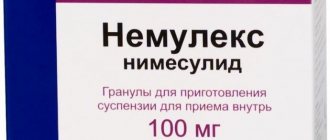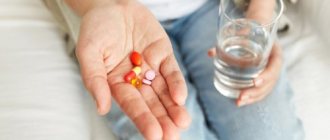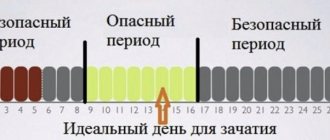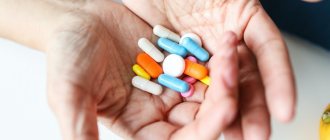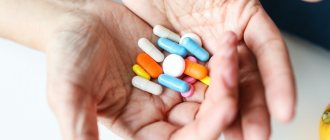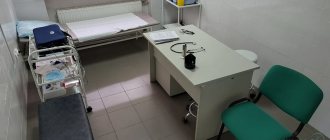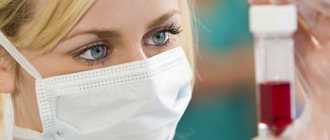Antibiotics are a group of medicines aimed at combating pathogenic bacteria. Once in the body, they suppress the growth of pathogenic flora and help eliminate infectious and inflammatory diseases. It is difficult to imagine the life of a modern person without antibiotics - they are widely used for bacterial complications of respiratory viral infections and exacerbations of chronic inflammatory diseases of internal organs, and can be used for preventive purposes after surgical interventions.
Despite the benefits of these drugs, their use does not go without a trace, because the active substances destroy not only pathogenic flora, but also beneficial bacteria. Dysbacteriosis occurs - an imbalance of microorganisms, which can cause damage to the digestive system. Poisoning and discomfort in the stomach while taking antibiotics are associated with a decrease in the volume of beneficial microflora, as a result of which opportunistic bacteria are activated. Often this condition is accompanied by symptoms of intoxication, especially diarrhea.
Why does diarrhea occur after taking antibiotics?
The development of complications during antibacterial therapy in the form of diarrhea is associated with a decrease in beneficial microflora, which is involved in a complex of digestive processes:
- breakdown and absorption of nutrients from food;
- evacuation of the contents of the stomach and intestines;
- residual digestion of food;
- removal of toxins and metabolic products;
- secretion and absorption of water in the intestine;
- formation of feces, regulation of their excretion.
Even with standard antibacterial therapy, leading to a slight imbalance, side effects may occur in the form of disruption of intestinal function.
In addition, bacterial infections themselves can contribute to diarrhea, which is the basis for taking antibiotics. The waste products of pathogenic bacteria have a toxic effect, and stool liquefaction may be associated with an increase in body temperature. Antibiotics fight the underlying agent and root cause of the disease, and in many cases they are truly necessary. However, this group of medications can worsen the digestive system.
The mechanism of development of diarrhea after a course of antibiotics
Antibiotic-associated diarrhea (AAD) develops as a result of the death of both pathogenic bacteria and beneficial microorganisms. An imbalance of microflora is called dysbiosis. According to statistics, the source of such digestive disorders can be up to ⅕ of the types of antibiotics used in medical practice. Typically, this phenomenon occurs as a result of taking broad-spectrum drugs.
Typically, this type of diarrhea does not have other symptoms, unlike food poisoning. The main symptoms of antibiotic poisoning include watery or loose stools, and less commonly, cramping abdominal pain. Most often, the intestinal condition returns to normal after 2-3 days.
In very rare cases, antibacterial therapy can cause colonization of the mucous membranes by pathogenic microorganisms - Clostridium difficile and Salmonella. They cause severe infections with persistent diarrhea, which increases the risk of dehydration and can lead to serious health consequences.
Antibiotic-associated diarrhea can occur with long-term use of suitable doses of the drug, and not necessarily in tablet form - injections can also lead to this result. However, poisoning can also occur due to an overdose. Each antibiotic has a toxic effect on different organs, so the category of the drug is taken into account. Common symptoms of overdose include the following:
- high body temperature (up to 39–40 ˚C);
- diarrhea;
- vomit;
- muscle pain;
- pain in the right hypochondrium;
- changes in blood pressure;
- tachycardia or bradycardia;
- joint pain;
- dizziness, etc.
With toxic damage to the liver, the following symptoms may appear: yellowness of the skin and sclera, itching of the skin, bloating, etc. With kidney damage, the volume of urine decreases significantly, and a strong feeling of thirst occurs. Poisoning with aminoglycosides leads to the appearance of signs of toxic otitis: acute pain in the ears, decreased hearing acuity, a feeling of congestion, etc. All conditions associated with an overdose of antibiotics require immediate treatment of poisoning . It is important to call an ambulance as soon as possible.
Medicines starting with the letter E
Enterofuril capsule analogs 3 synonyms and substitutes available. Savings from 86 to 116 rubles.
Analogues of Exifin cream There are 3 synonyms and substitutes available. Savings from 48 to 69 rubles.
Analogues of Erius tablets There are 3 synonyms and substitutes available. Savings from 73 to 108 rubles.
Analogs of effervescent tablets Efferalgan 3 synonyms and substitutes available. Savings from 101 to 133 rubles.
Analogues of Effezel gel There are 3 synonyms and substitutes available. Savings from 234 to 471 rubles.
Analogues of Enterosan capsules 3 synonyms and substitutes are available. Savings from 177 to 279 rubles.
Analogues of Enterol capsules 3 synonyms and substitutes available.
Analogues of Ergoferon tablets There are 3 synonyms and substitutes available. Savings from 57 to 88 rubles.
Analogues of Espumisan capsules There are 3 synonyms and substitutes available. Saving from 15 to 24 rubles.
Analogues of Exforge tablets There are 3 synonyms and substitutes available. Savings from 450 to 694 rubles.
Analogues of Enap tablets There are 3 synonyms and substitutes available. Savings from 83 to 122 rubles.
Analogues of Elokom ointment There are 3 synonyms and substitutes available. Savings from 130 to 212 rubles.
Analogues of capsules Essentiale forte N 3 synonyms and substitutes available. Savings from 140 to 446 rubles.
Analogs of Erexesil tablets 3 synonyms and substitutes available. Savings from 287 to 338 rubles.
Analogues of Ecositrin tablets There are 3 synonyms and substitutes available. Savings from 108 to 295 rubles.
Analogs of Ecomed tablets There are 3 synonyms and substitutes available. Savings from 55 to 217 rubles.
Analogues of Ermital capsules There are 3 synonyms and substitutes available. Savings from 13 to 145 rubles.
Analogues of Ersefuril capsules There are 2 synonyms and substitutes available. Savings from 130 to 246 rubles.
Analogues of Ednit tablets There are 3 synonyms and substitutes available. Savings from 13 to 39 rubles.
Analogues of Elafra tablets There are 3 synonyms and substitutes available. Savings from 486 to 1113 rubles.
Analogues of Efferalgan suppositories There are 3 synonyms and substitutes available. Savings from 38 to 78 rubles.
Analogues of the drug Editsin There are 3 synonyms and substitutes available. Savings from 449 to 510 rubles.
Analogues of Entegnin tablets There are 3 synonyms and substitutes available. Savings from 68 to 90 rubles.
Analogues of Egitromb tablets There are 3 synonyms and substitutes available. Savings from 230 to 450 rubles.
Analogs of Eleflox tablets There are 3 synonyms and substitutes available. Savings from 488 to 732 rubles.
Analogues of Efox Long tablets There are 3 synonyms and substitutes available. Savings from 144 to 235 rubles.
Analogues of Ecomed capsules There are 3 synonyms and substitutes available. Savings from 111 to 266 rubles.
Analogues of Exiter cream There are 3 synonyms and substitutes available. Savings from 146 to 215 rubles.
Analogs of Epicurus capsules 3 synonyms and substitutes available. Savings from 25 to 364 rubles.
Analogues of Elevit Pronatal tablets There are 3 synonyms and substitutes available. Savings from 389 to 504 rubles.
Analogs of Eutirox tablets There are 1 synonyms and substitutes available.
Analogues of Etatsizin tablets There are 3 synonyms and substitutes available. Savings from 730 to 966 rubles.
Analogues of Erazaban cream There are 3 synonyms and substitutes available. Savings from 15 to 182 rubles.
Analogues of Exoderil solution There are 3 synonyms and substitutes available. Savings from 63 to 221 rubles.
Analogues of Eglonil tablets There are 3 synonyms and substitutes available. Savings from 187 to 194 rubles.
Analogs of Eltacin tablets 6 synonyms and substitutes available. Savings from 39 to 136 rubles.
Analogs of Enterosgel paste 6 synonyms and substitutes available. Savings from 73 to 278 rubles.
Analogues of Enalapril tablets There are 4 synonyms and substitutes available.
Analogues of Erespal tablets There are 4 synonyms and substitutes available. Savings from 98 to 163 rubles.
Analogs of Emanera capsules 6 synonyms and substitutes available. Savings from 81 to 355 rubles.
Analogs of Egilok tablets 8 synonyms and substitutes available. Savings from 74 to 103 rubles.
Analogues of Emoxipin eye drops There are 2 synonyms and substitutes available. Savings from 8 to 136 rubles.
Analogues of the drug Enterodes There are 7 synonyms and substitutes available. Savings from 42 to 132 rubles.
Analogues of Edarbi tablets 7 synonyms and substitutes available. Savings from 143 to 345 rubles.
Escitalopram tablet analogs 7 synonyms and substitutes available. Savings from 148 to 148 rubles.
Analogues of Esomeprazole Canon tablets 7 synonyms and substitutes available. Savings from 34 to 171 rubles.
Analogues of the drug Elkar There are 2 synonyms and substitutes available. Savings from 265 to 265 rubles.
Analogs of Elidel cream There are 4 synonyms and substitutes available. Savings from 207 to 793 rubles.
Analogues of Emla cream There are 3 synonyms and substitutes available. Savings from 814 to 1618 rubles.
Analogs of Encephabol tablets 6 synonyms and substitutes available. Savings from 131 to 685 rubles.
Analogues of Ethoxidol tablets 6 synonyms and substitutes available. Savings from 224 to 495 rubles.
Analogues of Asipy tablets 6 synonyms and substitutes available. Savings from 34 to 163 rubles.
Analogues of Ecofuril capsules There are 3 synonyms and substitutes available. Saving from 30 to 30 rubles.
Analogues of Escapelle tablets There are 4 synonyms and substitutes available. Saving from 25 to 25 rubles.
Analogues of Eufillin tablets 4 synonyms and substitutes are available.
Analogues of Ezlor tablets There are 5 synonyms and substitutes available. Savings from 159 to 271 rubles.
Analogues of Etamzilat tablets There are 3 synonyms and substitutes available. Savings from 68 to 74 rubles.
Analogues of Epistat tablets There are 4 synonyms and substitutes available. Savings from 39 to 39 rubles.
Analogues of Excedrin tablets 6 synonyms and substitutes available. Savings from 82 to 120 rubles.
Analogue of Etamzilat-Ferein tablets There are 3 synonyms and substitutes available. Saving from 6 to 6 rubles.
Analogue of Etamzilat-Eskom solution There are 3 synonyms and substitutes available.
Analogue of Eufillin-UBF tablets 4 synonyms and substitutes available. Saving from 1 to 1 rub.
Analogue of eye drops Emoxipin-AKOS 2 synonyms and substitutes available. Savings from 128 to 128 rubles.
Analogue of Erispirus tablets 4 synonyms and substitutes available.
Enterumin powder analog 6 synonyms and substitutes available. Savings from 95 to 205 rubles.
Analogue of Enam tablets 4 synonyms and substitutes available. Savings from 26 to 26 rubles.
Analog tablets Ecotsifol 6 synonyms and substitutes available. Savings from 45 to 55 rubles.
Analogue of Ethambutol-Acri tablets 2 synonyms and substitutes available. Savings from 14 to 14 rubles.
Analogue Erythromycin-AKOS 4 synonyms and substitutes available. Saving from 0 to 0 rub.
Analogue of Elzhin There are 7 synonyms and substitutes available. Savings from 88 to 200 rubles.
Analogue of Enanorm tablets 3 synonyms and substitutes available. Savings from 47 to 181 rubles.
Analogue of Equacard tablets There are 3 synonyms and substitutes available. Savings from 134 to 134 rubles.
Analogue of tablets Equator 3 synonyms and substitutes available.
Analogue of Evkazolin Aqua spray There are 3 synonyms and substitutes available. Savings from 1 to 36 rubles.
Analogue of Enalapril-Teva tablets 3 synonyms and substitutes available. Savings from 26 to 26 rubles.
Analogue of Enalapril-FPO tablets 3 synonyms and substitutes available.
Analogue of Esparoxi tablets 3 synonyms and substitutes available. Savings from 82 to 126 rubles.
Analogue of capsules Essliver forte 3 synonyms and substitutes available.
Analogue of Exluton tablets 3 synonyms and substitutes available. Savings from 608 to 2774 rubles.
Analogue of Estrocad candles 5 synonyms and substitutes available. Savings from 79 to 372 rubles.
Analogue of Espol ointment 2 synonyms and substitutes available. Savings from 153 to 153 rubles.
Analogue of Eubicor powder There are 3 synonyms and substitutes available.
Analogue of chewable tablets Ektalust 7 synonyms and substitutes available. Savings from 57 to 57 rubles.
Analogue of lozenges Eucalyptus-M 3 synonyms and substitutes available. Savings from 104 to 104 rubles.
Analogue of Ecodax cream 7 synonyms and substitutes available. Savings from 82 to 82 rubles.
Analog of Enema Wedge solution 1 synonyms and substitutes available.
Etonium ointment analog 7 synonyms and substitutes available. Saving from 24 to 24 rubles.
Analogue of Elitseya tablets 14 synonyms and substitutes available. Savings from 3 to 559 rubles.
Analogue of Estrolet tablets 2 synonyms and substitutes available.
Analogue of Eliquis tablets 3 synonyms and substitutes available. Savings from 762 to 762 rubles.
Analogue of Enap-NL tablets 6 synonyms and substitutes available. Savings from 62 to 115 rubles.
An analogue of a set of Enzix tablets. 10 synonyms and substitutes are available. Savings from 2 to 185 rubles.
Analogue of vaginal suppositories Ecofucin 7 synonyms and substitutes available. Savings from 2 to 151 rubles.
Analogue of Espumisan L 6 synonyms and substitutes available. Savings from 83 to 336 rubles.
Estrogel gel analog 6 synonyms and substitutes available. Savings from 61 to 293 rubles.
Analogue Efferalgan 2 synonyms and substitutes available. Saving from 24 to 24 rubles.
Analogue of Epiterra tablets There are 3 synonyms and substitutes available. Saving from 60 to 60 rubles.
Analogue of Elcet tablets 3 synonyms and substitutes available.
Analog of Emetron ampoules. 3 synonyms and substitutes available. Savings from 789 to 869 rubles.
Analogue of Egolanza tablets 6 synonyms and substitutes available. Savings from 566 to 922 rubles.
Analogue Erythromycin ointment There are 5 synonyms and substitutes available.
Analogue of Emoxy-optik eye drops 10 synonyms and substitutes available. Savings from 2 to 24 rubles.
Analogue of Elisey tablets 9 synonyms and substitutes available. Savings from 4 to 112 rubles.
Analogue of Eladon tablets 5 synonyms and substitutes available. Savings from 59 to 222 rubles.
Analogue of Elbon ampoules There are 3 synonyms and substitutes available. Savings from 131 to 657 rubles.
Analogue of tablets Ekolevid 8 synonyms and substitutes available. Savings from 102 to 221 rubles.
Analogue of tablets Exifin 4 synonyms and substitutes available. Savings from 340 to 555 rubles.
Analogue of Echinacea tablets 9 synonyms and substitutes available. Savings from 33 to 90 rubles.
Analogue of tablets Estifan 3 synonyms and substitutes available.
Analogue of Exchol capsules 8 synonyms and substitutes available.
Analogue of Enixum solution 7 synonyms and substitutes available. Savings from 162 to 1552 rubles.
Analogue of Espiro tablets 5 synonyms and substitutes available. Savings from 492 to 529 rubles.
Analog of capsules Evenzym 4 synonyms and substitutes available.
Analog of Eclaran 5 gel There are 5 synonyms and substitutes available. Savings from 2 to 152 rubles.
Analogue of Eldepril tablets There are 4 synonyms and substitutes available. Savings from 130 to 381 rubles.
Analogue of Encorat tablets 5 synonyms and substitutes available. Savings from 123 to 216 rubles.
Analogue of Elzepam tablets 10 synonyms and substitutes available. Savings from 1 to 8 rubles.
Analogue of Ecobol tablets 6 synonyms and substitutes available. Savings from 42 to 42 rubles.
Analogue of Esperal tablets 4 synonyms and substitutes available. Savings from 400 to 1150 rubles.
Analogue of Exelon capsules 3 synonyms and substitutes available. Savings from 192 to 1441 rubles.
Analogue of Ecoclave tablets 10 synonyms and substitutes available. Savings from 100 to 127 rubles.
Analogue of Enzistal tablets 10 synonyms and substitutes available. Savings from 5 to 28 rubles.
Treatment of antibiotic-associated diarrhea
Diarrhea that develops while taking antibiotics requires adjustment of the treatment regimen. You should not stop taking medications on your own; you should consult your doctor. Typically, the course of antibacterial therapy is interrupted or the drug is replaced with an antibiotic of a different group.
Normalization of digestive processes, intestinal motility and stool consistency are tasks that require an integrated approach. There are three general principles that are important for all people suffering from diarrhea after taking antibiotics:
- Nutrition correction: it is important to follow a diet. The diet should include crackers and rice water. It is important to reduce the amount of carbohydrates consumed as much as possible, and also give up milk, dairy products, baked goods, fresh vegetables, berries and fruits; legumes, pasta.
- Compliance with the drinking regime: it is necessary to drink at least 2 liters of water per day to replenish fluid loss during watery stools.
- Symptomatic therapy: the pathological process can be stopped with the help of medications.
Due to the fact that many sources of natural probiotics and prebiotics are prohibited for diarrhea, one of the key principles of treatment is the prescription of medications containing these components. Strict dietary restrictions require the use of probiotics and prebiotics for antibiotic-associated diarrhea: it is important to restore normal intestinal microflora to prevent the proliferation of opportunistic microorganisms.
In most cases, medication correction is indispensable. Remember that only a doctor can prescribe medications.
There are several groups of drugs that can be recommended for antibiotic-associated diarrhea.
Sorbents
Infectious and inflammatory diseases are accompanied by intoxication of the body, and in the process of antibacterial therapy, decay products of pathogenic microflora accumulate. Therefore, the doctor may prescribe enterosorbents - products that literally absorb toxins and harmful substances and remove them from the body.
Probiotics and prebiotics
It is important to address the root cause of diarrhea and restore normal intestinal microflora after taking antibiotics. For this, probiotics are used - bifidobacteria, lactobacilli, as well as prebiotics - a nutrient substrate to stimulate the growth of one's own beneficial microflora. Synbiotics include both probiotics and prebiotics and are widely used in gastroenterological practice.
If there is a pronounced shift in the microbial balance, the doctor may recommend intestinal antiseptics or bacteriophages - they are designed to prevent the growth of opportunistic microflora and help restore the number of beneficial microorganisms.
Enzymes
Enzyme replacement therapy is not the mainstay of treatment for antibiotic poisoning. However, preparations based on digestive (pancreatic, gastric, intestinal) enzymes stimulate the digestion of food, normalize intestinal motility and peristalsis and participate in the restoration of normal microflora of the large intestine.
Symptomatic therapy
Diarrhea is often accompanied by painful symptoms: flatulence, nausea, cramping and abdominal pain. You can quickly alleviate the condition with the help of medications. They are unable to cope with the main problem, but will bring temporary relief. Report your symptoms to your doctor, and he will select one or more remedies to improve your well-being:
- for increased gas formation - defoamers (drugs based on simethicone) or herbal carminatives;
- analgesics or antispasmodics for pain;
- Oral rehydration solutions are products designed to replenish normal fluid volume and prevent dehydration.
If diarrhea is accompanied by elevated body temperature, the doctor will select an antipyretic drug.
General strengthening agents
Weakened by an infectious or inflammatory disease, as well as subsequent use of antibiotics, the body may require complex recovery. A specialist can prescribe immunomodulators, vitamin-mineral complexes and restorative drugs.
Restrictions in food during diarrhea can also cause hypovitaminosis and lack of minerals. During long-term antibiotic therapy, it is necessary to discuss preventive measures with your doctor in advance.
Antidiarrheal drugs
If you cannot cope with diarrhea, your doctor may prescribe drugs from the following groups:
- eubiotics - live bacteria that are designed to restore the balance of intestinal microflora and restore normal digestive function;
- synthetic drugs based on loperamide: bind to opioid receptors of the intestinal wall and inhibit the release of mediators that stimulate intestinal motility;
- herbal preparations based on tannins.
Sorbents also have an antidiarrheal effect. They are natural and synthetic. Enterosorbents, entering the intestines, absorb toxins and harmful substances, contribute to the formation of stools and their reduction. It is important to remember that at least two hours should pass between taking sorbents and other drugs.
For severe antibiotic-associated diarrhea, antibacterial agents targeting Clostridium difficile or another infectious agent may be appropriate.
The drug “Fitomucil Sorbent Forte” can be used as an adjunct to relieve diarrhea syndrome. It contains inulin, a prebiotic that promotes the growth of normal microflora, as well as 5 types of probiotic bacteria. In addition, the drug contains psyllium, a natural component that helps reduce diarrhea and relieve intoxication, since it turns into a gel and absorbs toxins. The triple effect (enterosorbing, detoxifying and restorative) distinguishes Fitomucil Sorbent Forte from other sorbents prescribed for AAD. Live bacteria populate the intestines and not only help relieve diarrhea, but also improve the condition of the microflora that has been damaged by taking antibiotics.
However, to restore microflora it is not enough to take one drug.
Only a doctor prescribes specific therapy. It is necessary to stop taking uncontrolled medications and agree with a specialist on medications for symptomatic therapy.
Gynoflor E, vaginal tablets 6 pcs.
Manufacturer
Haupt Pharma Amareg GmbH, Germany
Compound
Active ingredients:
Lactobacillus acidophilus lyophilisate 50 mg (at least 100 million viable bacteria) and estriol 0.03 mg.
Excipients:
lactose monohydrate,
microcrystalline cellulose,
sodium starch glycolate,
magnesium stearate,
sodium phosphate dibasic anhydrous.
pharmachologic effect
Gynoflor E is an antimicrobial and antiseptic agent that is used in gynecology. Contains active substances identical to those naturally found in the human vagina. A healthy vagina is in a state of biological balance and has a natural defense mechanism against infections.
Lactobacilli bacteria form a major part of this defense mechanism, producing lactic acid and other substances that have an anti-infective effect. The production of lactic acid results in the formation of an acidic environment, which promotes the development of Lactobacilli bacteria and inhibits the development of pathogenic microorganisms.
Disturbance or destruction of the vaginal fermented milk flora can occur as a result of treatment with certain drugs (eg, antibiotics), due to local infections, serious systemic diseases or improper hygiene measures (vaginal rinses and douches). Gynoflor E contains high doses of viable Lactobacilli bacteria, which help restore the natural flora of the vagina. In addition to the natural flora, the condition of the vaginal epithelium is very important for the natural protective mechanism of the vagina. It can be damaged by fluctuating or deficient hormone levels (especially during or after menopause) and vaginal infections.
The second active substance of Gynoflora E is estriol, which is a natural female sex hormone. Estriol, even in a very low dose contained in Gynoflora E, ensures restoration of the vaginal epithelium, good blood circulation in it, sufficient thickness, elasticity and hydration. It is also important for the development of Lactobacilli bacteria in the vagina. Both Lactobacilli bacteria and estriol act locally in the vagina.
The lactose contained in vaginal tablets can be quickly fermented by Lactobacilli bacteria into lactic acid. Thus, after the first use of the drug, the reproduction and recolonization of Lactobacilli bacteria begins.
Indications
- To restore the Lactobacillus flora after treatment with certain medications (eg antibiotics);
- for the treatment of local disorders during and after menopause (vaginal dryness, itching, burning, pain during sexual intercourse) and as a concomitant treatment during systemic hormone replacement therapy;
- for the treatment of vaginal discharge of unknown origin or mild to moderate cases of vaginal infections for which the use of antibiotics or chemotherapy is not strictly necessary.
Use during pregnancy and breastfeeding
The experience of using Gynoflor E during pregnancy does not indicate any undesirable effects on pregnancy or the health of the fetus of the newborn child.
The active substances, Lactobacillus acidophilus and estriol, are naturally found in the vagina, and after using Gynoflor, levels of both substances did not exceed those in healthy women.
Thus, Gynoflor E can be used during pregnancy. As with any medicine during pregnancy, consult your doctor.
Gynoflor E can be used during lactation.
Contraindications
- Hypersensitivity to estriol, Lactobacilli bacteria or other Gynoflora E substances;
- estrogen-dependent tumors in the mammary glands, uterus or vagina;
- endometriosis;
- vaginal bleeding of unknown origin;
- not recommended before the first menstruation.
Side effects
A slight burning or hot sensation; redness and itching.
Interaction
Concomitant treatment with anti-infective agents (for example, local or systemic antibiotics) may lead to a decrease in the effectiveness of Gynoflor E.
Tell your doctor if you are taking or have recently taken other medications, even those that were not prescribed for you.
How to take, course of administration and dosage
To restore a healthy vaginal environment, to treat vaginal discharge and infections: 1-2 vaginal tablets are recommended every day for 6-12 days.
For the treatment of local disorders during and after menopause (vaginal dryness, itching, burning, pain during sexual intercourse), as a concomitant medication during systemic hormone replacement therapy: 1 vaginal tablet every day for 6-12 days, thereafter prophylactic dose: 1 vaginal tablet 1-2 days a week.
Insert the vaginal tablet deep into the vagina in the evening before going to bed. It is better to do this lying on your back, with your knees slightly bent. Stop treatment during menstruation and start again after menstruation has stopped.
Special instructions
If you experience unexpected vaginal bleeding, treatment should be stopped and your doctor should investigate the cause of the bleeding.
During treatment with Gynoflor E, do not use vaginal douches or rinses Gynoflor E contains components that are not completely broken down; tablet remnants can sometimes be found on underwear. This does not affect the effectiveness of the drug.
In isolated cases, if the vagina is very dry, the vaginal tablet may not dissolve and may come out of the vagina in its original form. In this case, the treatment is not optimal, although it does not harm the vagina. To prevent such cases, the tablet can be moistened with a small amount of plain water before administration.
During treatment with Gynoflor E, pads should be used.
Release form
Pills
Storage conditions
At 2–8 °C (do not freeze)
Best before date
3 years
Active substance
Lactobacillus acidophilus lyophilisate, Estriol
Dosage form
vaginal tablets
Purpose
For postmenopausal women, For menopausal women, For adults as prescribed by a doctor
Indications
Menopause, Vaginitis
Barcode and weight
Barcode: 7640135180098, 5997001308745 Weight: 0.015 kg
Prevention of diarrhea during antibiotic therapy
To prevent diarrhea while taking antibiotics, it is important to follow several recommendations:
- strictly adhere to the dosage and treatment regimen prescribed by the doctor;
- use probiotics recommended by a specialist;
- follow a diet to prevent gastrointestinal disorders;
- maintain optimal drinking regime;
- take medications that protect the lining of the stomach and the entire digestive tract. If you have chronic ailments, you must inform your doctor about them so that he can select an individual scheme for protecting the digestive system from the effects of antibiotics.
If it is necessary to take antibiotics, it is important to take into account the body's previous reactions to antibacterial therapy. Thus, in some patients, antibiotic-associated diarrhea develops in response to exposure to a particular group of drugs or a specific agent.
How to choose a good allergy remedy for adults
All antihistamines are divided into 3 generations. The “older” the generation, the better and longer the effect, and the fewer side effects on the body.
First generation drugs
Developed in the early 40s of the last century. They act quickly - usually within the first 20-30 minutes, eliminating symptoms and significantly alleviating the person’s condition. However, their effect does not last long - on average 4-6 hours. In addition, they have quite serious side effects:
- increased drowsiness;
- decreased attention;
- nausea and even vomiting;
- headache;
- increased eye pressure;
- deterioration of coordination and a number of others.
They should not be taken for a long time, as they are addictive. But they have a low price, and they are available in the form of tablets, injections, drops (you can choose the most convenient option to use).
Suprastin
It acts quickly, has few side effects, in particular, does not cause severe drowsiness. Helps with various forms of allergies.
Important! For bronchial asthma, it is better to look for another remedy!
Diphenhydramine
Very effective, but many side effects. Available only by prescription.
Tavegil
Quickly relieves symptoms, acts for 8-12 hours (longer than all others). Causes severe drowsiness and vasoconstriction; it should not be used together with antidepressants and blood pressure medications.
Second generation drugs
Developed in the 80-90s of the last century. They have fewer side effects than their “predecessors” - in particular, they practically do not cause drowsiness. Long validity period - from 12 to 24 hours. However, when using it, the dosage must be strictly observed: otherwise, interruptions in the functioning of the heart can be provoked.
Claritin
The safest remedy without sedation. It can be prescribed even to children from 3 years of age. If necessary, it is used for a long time.
Note! People who have liver problems should first consult a doctor before taking the drug.
Gistalong
Effective even for chronic allergies. The longest duration of action of all 2nd generation antihistamines. Not prescribed to people over 60-65 years of age. Prohibited for heart problems.
Terfenadine
A good remedy for allergies, allergic conjunctivitis and rhinitis, as well as bronchial asthma (as part of a complex treatment). Begins to act within 1-2 hours and is effective for 12 hours.
Third generation drugs
Developed after 2000. They begin to act very quickly and as efficiently as possible. They have virtually no contraindications or side effects, and have a long-lasting effect (up to 48 hours or longer). They do not affect the functioning of the heart and can be used for long-term therapy.
Erius
After administration, the effect occurs almost immediately and does not decrease throughout the day. Removes allergy symptoms and prevents their reappearance.
Note! Patients with kidney failure should take the tablets under the supervision of a doctor.
Iridina Antistaminiko
Iridina Antistaminico eye drops are an excellent product made in Italy to eliminate allergic reactions accompanied by tearing, redness and inflammation of the eyes, or dryness. The drops quickly remove inflammation, constrict the blood vessels of the eyes, and moisturize the cornea. Since the drug has contraindications (for example, high eye or blood pressure), prior consultation with an ophthalmologist is necessary.
Eye drops Iridina Antistaminico
Xizal
Quickly and effectively relieves symptoms and inflammation. Valid for up to 2 days. It is prohibited for use by people with renal failure.
Nalkrom
Nalcrom is perhaps the best allergy remedy for adults today (also developed in Italy). Used to treat allergies of various origins, including for the prevention and treatment of allergic keratoconjunctivitis and conjunctivitis. Prescribed to people with weak bronchi and a number of gastrointestinal diseases. When treating mastocytosis, the effect lasts up to 2-3 weeks.
Nalkrom
Important! This is a potent drug, so prior consultation with a specialist is required!
